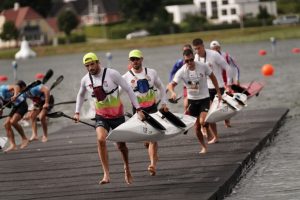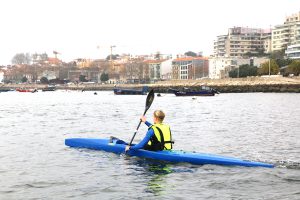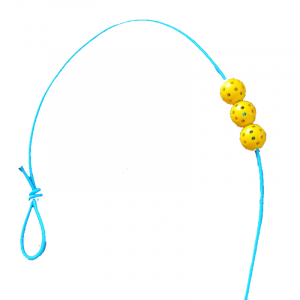“Be sure to match the paddle to your paddling technique, not the other way around“

With today’s wide array of choices when it comes to paddles, from blade design to shaft stiffness, having all the facts will help you to make an informed decision as to which paddle is the right one for you.
Paddles were originally “flat”, and if you have ever tried a flat blade you will have new respect for the sprint/marathon paddlers who managed to get such fast times using these blades.
Then in 1986 the first wing blades were designed (thankfully!) by the Swedes. (Thanks Ivan Lawler for the info!) The original blade was very symmetrical (think parallel-edged) and rather large.
Since then, there has been a number of paddle designs that have come into use, with a couple of really interesting blades being popular over the years.
Here are some points to consider when you are choosing a paddle:
1. Paddle Shape
Today there are basically 3 main blade designs – a tear drop (asymmetrical) and a more parallel edge (symmetrical) design, and then a kind of “hybrid” between the two, which is not totally tear dropped, but more asymmetrical than parallel-edged.
Generally speaking, the parallel edged blades have a more constant power application throughout the stroke, and the blade feels feels more stable in the water with more even behavior. The blade seems effective no matter where you place it, and it definitely provides a great point to lock against. Good examples of these types of blade are the original Lettman and the Gut. Great paddlers like Kenny Wallace use the Gut – a large, parallel edged blade.
The tear drop shapes start narrow and then form a big “tear drop”. Some are more pronounced than others, and have different degrees of twist. These shapes tend to have a smooth catch and exit. Certain of the tear drop shapes have a distinctive feel to the “power” phase of the stroke, with it being slightly delayed compared to the hybrid style and quite brief. The NK Wing is a good example, and having the blade very vertical in the water optimizes its effectiveness.
The tear drop shape seems to get to the vertical position quickly which is probably why these blades seem to work well with high stroke rates and going fast! (Max Hoff set the world’s fastest 1000m time using this shape, and Lisa Carrington has the most consistent fastest 200m time in the world). The blade style also handles rough water well.
Good examples are the Jantex Gamma, the Bracsa Van Dusen and the NK Wing and Clubline paddles.

The hybrid shape offers the best of both worlds, being both solid at the catch and evenly behaved and stable throughout the stroke. These blades have a good catch “feel” that helps with applying power at the beginning of the stroke. These paddles shapes definitely favor the catch phase of the stroke, and is a very effective paddle. I used this shape throughout my sprint career, and it is a very popular shape amongst Canoe Sprint.
Good examples are the Braca 1, and IV.
2. Shaft
We have a few variables here – fixed vs split, percentage of carbon (how stiff it will be), thickness and weight.
Split shafts are fantastic for travel, not just getting down to your local paddling spot but flying too. I hardly use a fixed shaft anymore, just sometimes on the rivers as I like having the smoothness (no joiner). The joiners of the past used to slip, or worse – lock out, making it very tough to separate the paddle! These days they are fantastic and come in either aluminium or a hard plastic It’s still a great idea to wash them off after every use, especially after salt water use. Solid shafts are sometimes used by 200m sprinters as they want every bit of rigidity they can get!
Most shafts can be made of either fiberglass, or a combination of glass and carbon, or full carbon. On a sliding scale, the glass shafts offer the most flex, wheres the full carbon are the most rigid.
Factors to consider with regards to how stiff the shaft for your paddle should be are:
- What are you using the paddle for (going for that Olympic final? Might be a good idea to not lose any energy in your stroke and get as much rigidity as possible).
- Your age – young, developing paddlers as well as older paddlers should go for a shaft with a lot of flex. Goal here is to reduce injury risk.
- Water type – bumpy ocean or glass-like lake?
- Training Volume – huge mileage or ridiculously long races will make your joints happy if you opt for a shaft with more flex.
Some paddle manufacturers offer skinny shafts – great for kids or people with smaller hands. There is also sometimes an option of a lighter shaft, which is awesome!
3. Blade Construction
Again, paddles can be made with varying amounts of carbon. Same idea here when considering youth and injury prevention vs rigidity and no energy dissipation.
Depending on what kind of water you train in most often, you might want to consider a different layup for your blade – think reinforced tips for rocky rivers, super light for marathon distance and ski, and slightly thicker, more durable constructs for club/multiple people use.
4. Blade Size
Blade size is an individual preference. Back in the day, paddles were massive! Nowadays, the trend has definitely moved to a smaller paddle size, even in SUP.
Consider that the bigger the blade, the more strength required to use it effectivley. What feels great when you start your 2 hour paddle, might bite you in the butt after your 15th interval in that 30km race!
Personal differences to take note of:
- Strength: the bigger the blade – the bigger the biceps 🙂
- Race length: are you training for the 50km Cape Point Challenge or the 200m Sprint Nationals? I like to think of my paddle size like a bike gear. I use a “granny gear” because I mainly race long distance, and need to still be able to sprint (for a run, for the finish) after a number of hours out on the water.
- Type of water: flowing, ocean or flat all have different demands. I use a much smaller blade size nowadays compared to my Olympic flat water time. I mainly race in the ocean, and the smaller blade makes my life a lot easier.

5. Paddle Length
Again, a personal preference. In terms of force production, having a longer paddle allows more force to be produced through having a longer lever. However, the longer the paddle, the harder to get your stroke rate up, but too short and you are losing our on potential speed. The best would be to use a cadence sensor like the Vaaka, and determine your optimum stroke rate and the paddle length that corresponds.
6. Paddling Technique
We all have unique paddling styles (all of which are improvable if need be) but ultimately our individual styles are how we move ourselves through the water. There are no “normal” body shapes and sizes, and we all have different length arms and trunks.
Ideally you need to get a qualified pair of eyes on you while you paddle, using a number of different paddle shapes, and then go with your subjective feeling, added to some objective data (GPS speed, cadence) and the good technical coaches feedback, to make a really informed decision.
Your goals should be comfort, optimum speed, and reduced likelihood of injury.
I hope this helped you somewhat, please reach out in the comments section or directly on hello@nelous.com to ask any questions. If you’d like help setting up your paddle to an optimum length for your style, you can book a Technique Coaching session..





